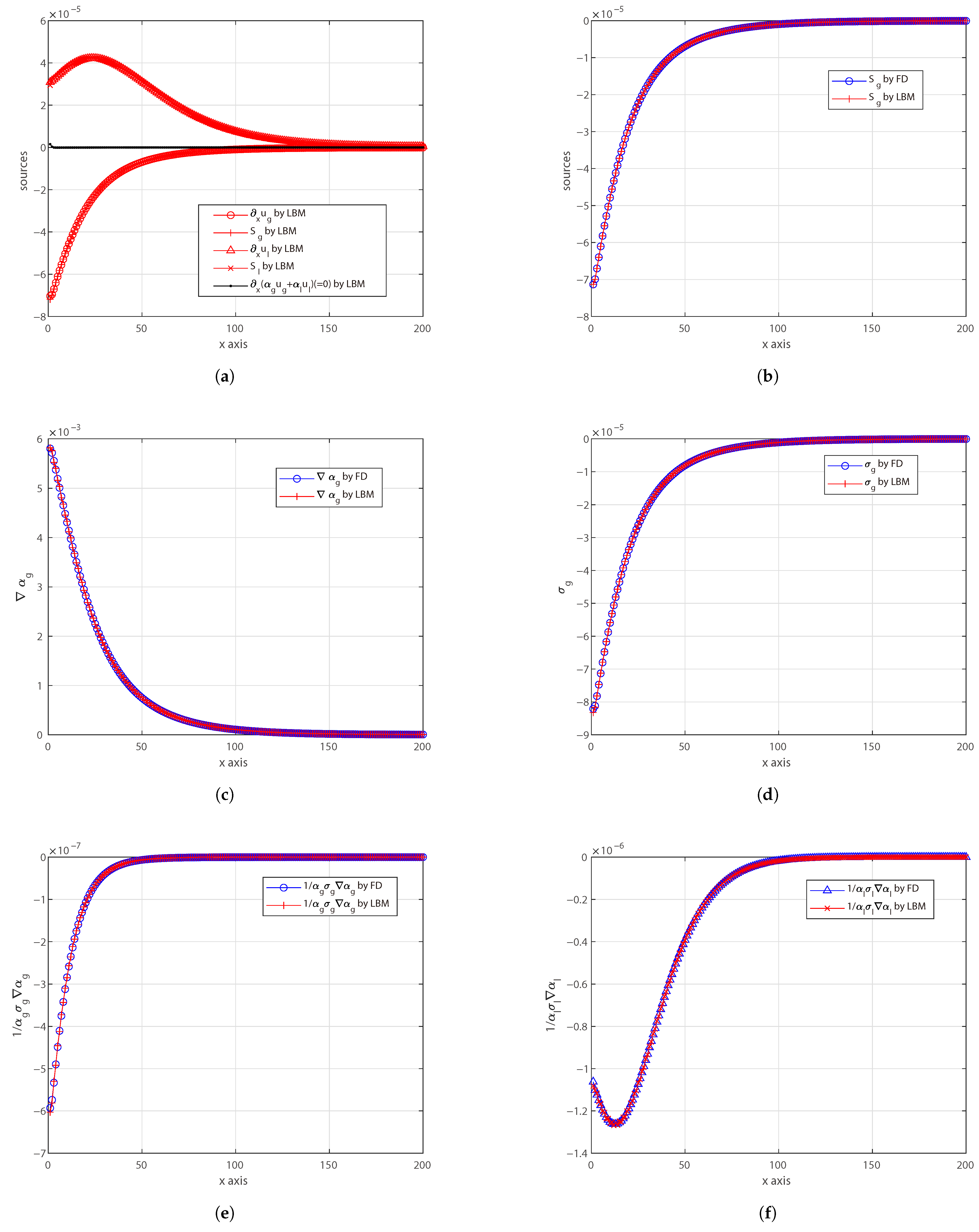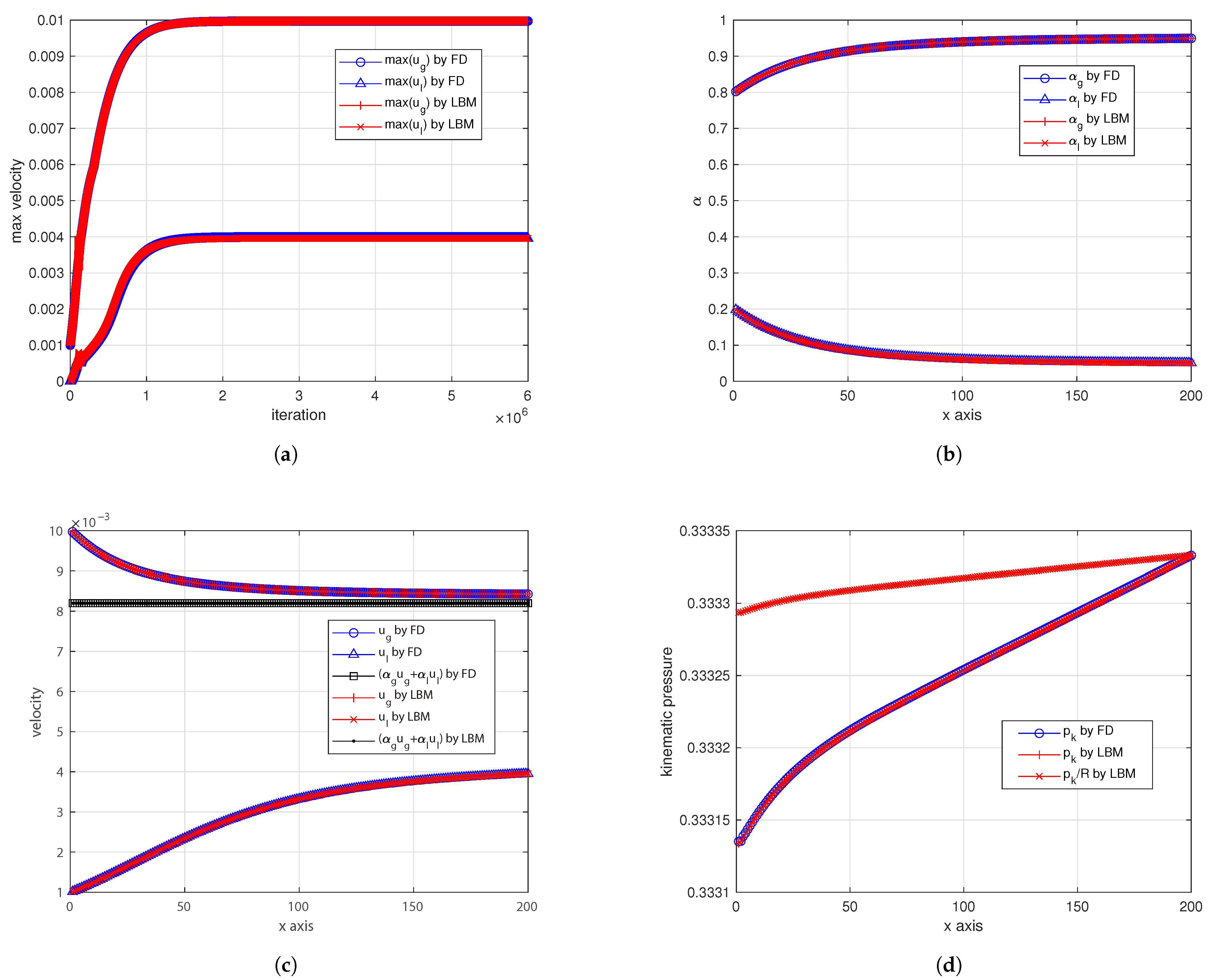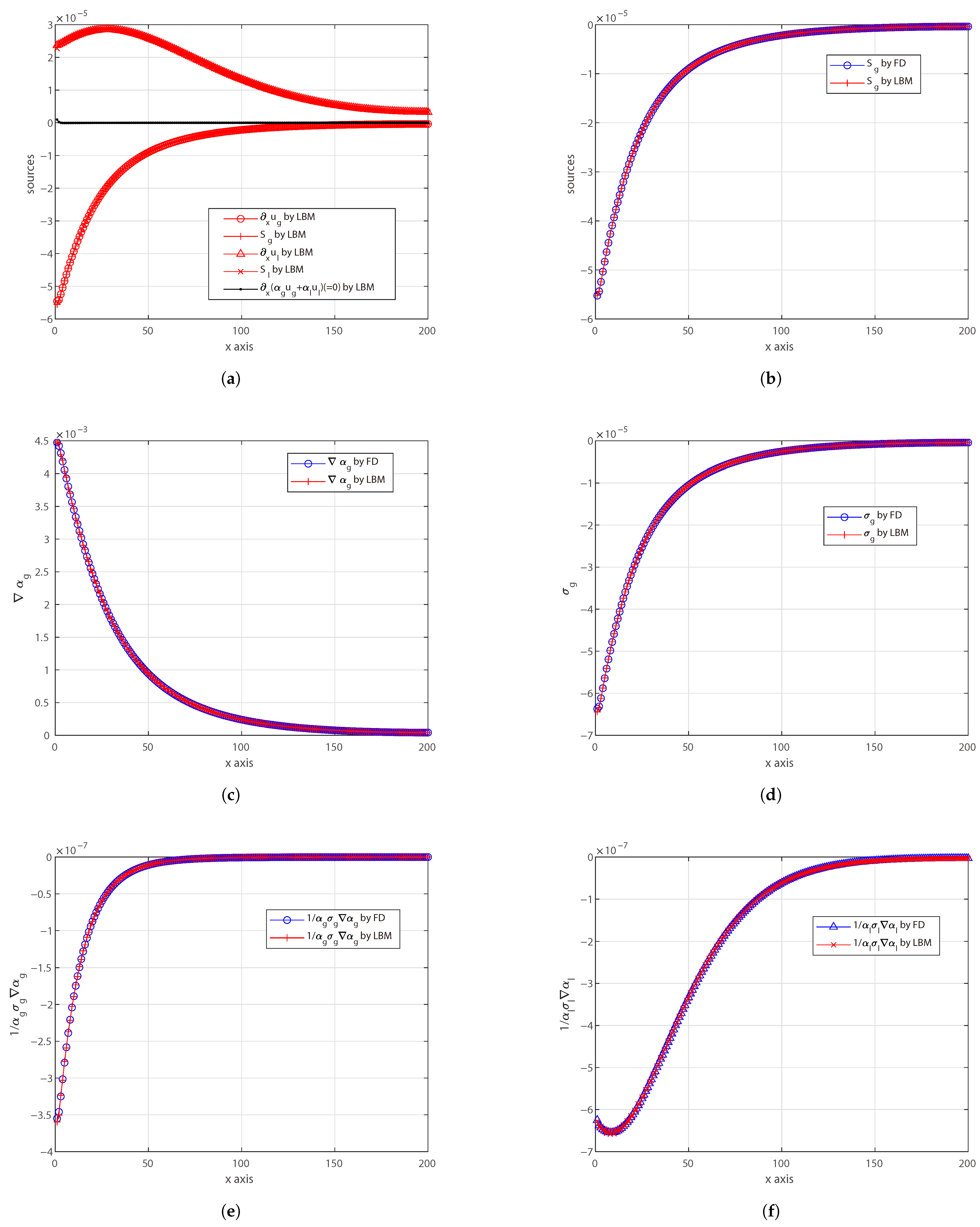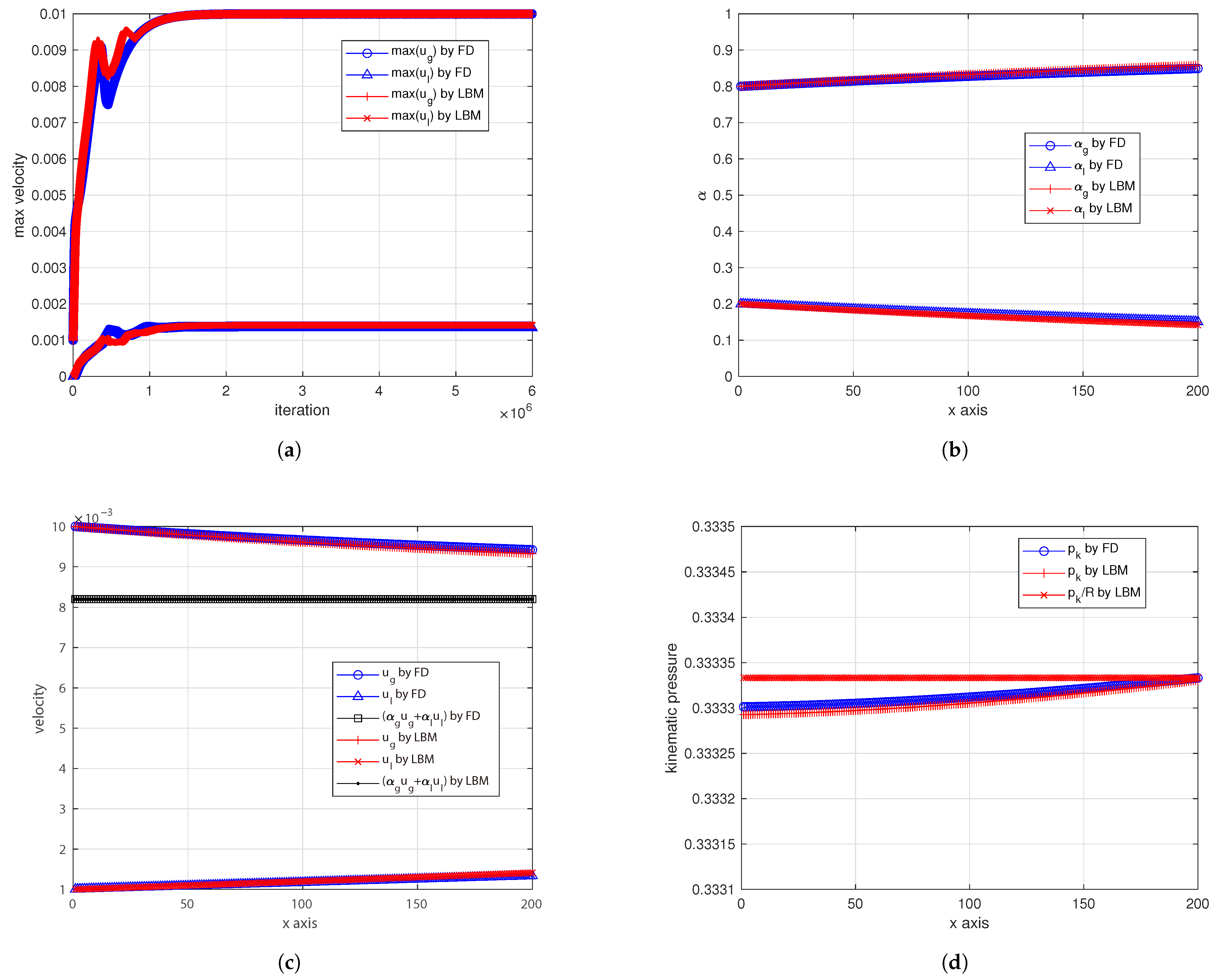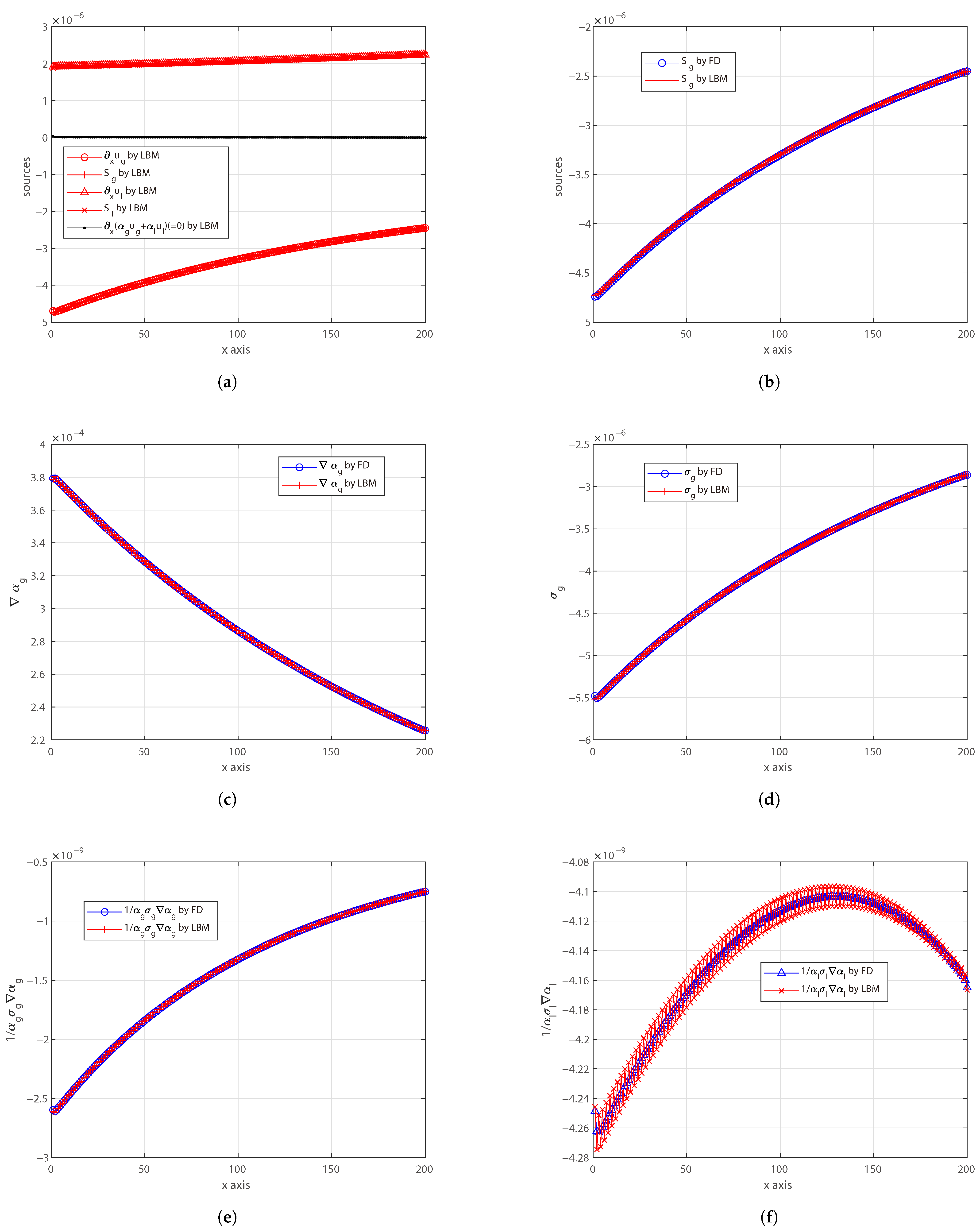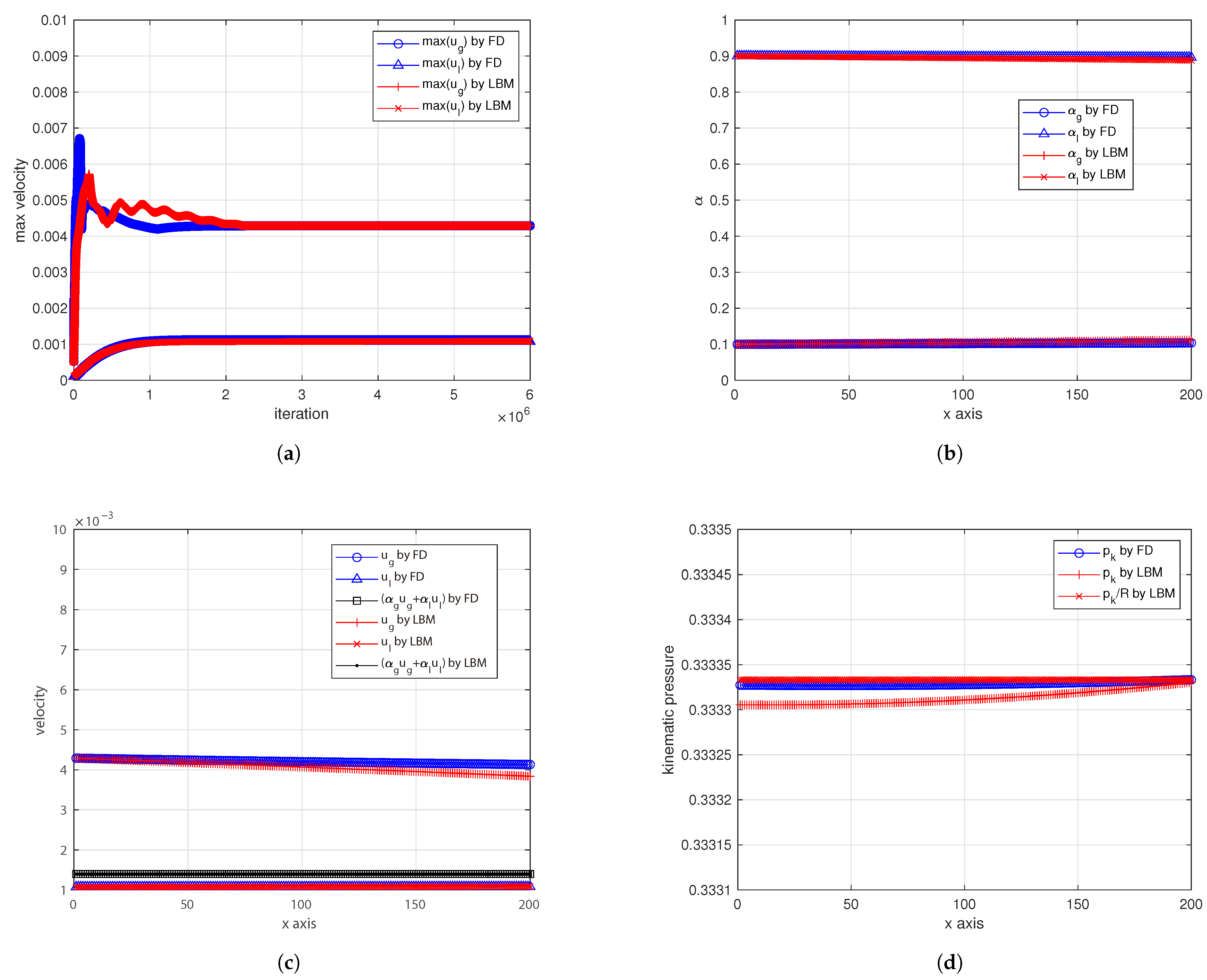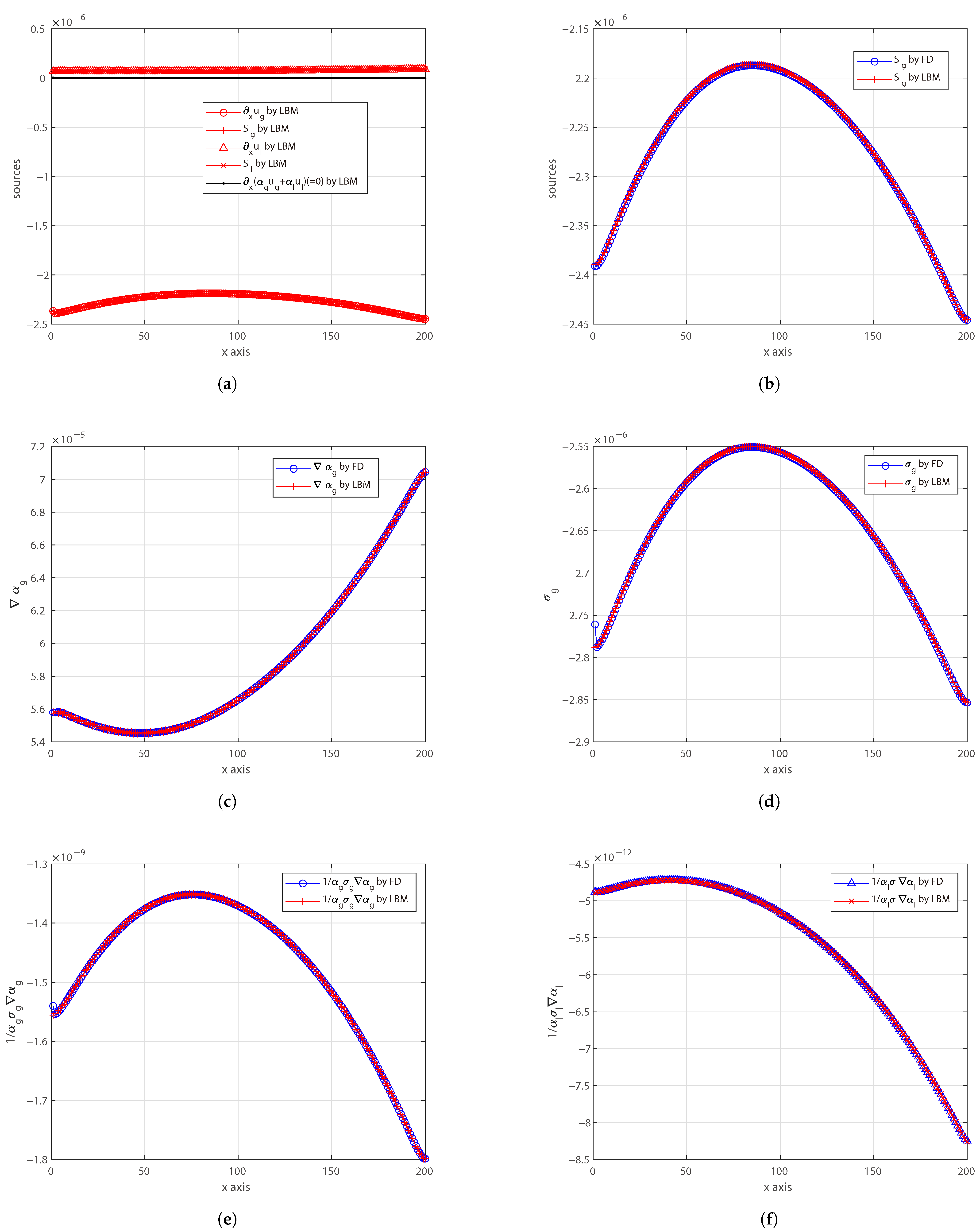1. Introduction
The computational fluid dynamics (CFD) of multiphase flows is crucial in the energy sector, particularly in oil and gas, as it enables the detailed simulation and optimization of complex fluid interactions, such as those in bubble column reactors. These reactors are used extensively in refining processes, gas treatment, and chemical synthesis, where accurate modeling of gas–liquid interactions can lead to improved efficiency, reduced energy consumption, and enhanced safety. Using CFD, industry can better understand the flow dynamics, optimize reactor designs, and ultimately reduce costs and emissions, making it a vital tool for the advancement of sustainable energy solutions.
A multiphase flow system consists of the simultaneous flow of materials with different phases or states of matter in regions bounded by moving interfaces. The lattice Boltzmann method (LBM) has garnered significant interest for modeling multiphase flows, particularly because its inherent parallelism makes it ideal for high-performance computing applications when dealing with large domains. Notably, diffuse interface approaches have become well-established for simulating such flows without relying on Lagrangian meshes and immersed boundaries [
1]. Among these, “color gradient” LBM techniques have proven to be particularly effective for modeling multiphase flows in porous media and microchannels [
2]. The color-gradient method assigns different “colors” to each fluid and uses recoloring algorithms to maintain immiscibility and model surface tension. It is known for robustness and numerical stability, accommodating moderate-density ratios (up to ∼100). Various strategies have been developed to incorporate surface tension into LBMs. For example, pseudo-potential models, originally introduced by Shan and Chen, simulate surface tension through pairwise molecular interactions [
3,
4]. They introduce phase separation through a density-dependent interparticle force. They are widely used due to their simplicity and and work best for moderate-density ratios (typically up to ∼100, or ∼1000 with advanced forcing schemes). The free-energy method employs a Ginzburg–Landau-type free energy functional to model interfacial dynamics and control surface tension precisely. It is suitable for capturing diffuse interfaces but is typically limited to lower-density ratios (∼10–20) [
5]. Furthermore, phase-field models solve a coupled Cahn–Hilliard equation to evolve an order parameter representing phase concentration. It shares many features with the free-energy approach, including good interface capturing and limited-density-ratio capabilities [
6]. However, all these lattice Boltzmann methods are generally formulated to solve a single-fluid set of equations with a diffuse interface or interfacial force rather than separate momentum equations for each phase. This means they do not directly solve two separate Eulerian momentum equations coupled with drag. Instead, they treat the multiphase system as a single effective fluid with an internal interface. Accurately capturing phase interfaces becomes particularly difficult in complex systems, such as a swarm of bubbles like those seen in the bubble column reactors. Furthermore, these models often introduce an artificial dependence of surface tension on viscosity, leading to numerical instabilities and artifacts at fluid interfaces [
7]. A possible approach to modeling multiphase flows without simulating the interface is the mixture approach, which essentially treats the multiphase system as a single mixture with properties that are weighted averages of the different phases [
8]. Instead of solving separate momentum equations for each phase, a single momentum equation is solved for the mixture. For this reason, it is a simple and computationally convenient approach but with a lower detail level because a proper model must be provided for the velocity difference between the two phases. It needs small relative velocities, so it is more suitable for closely coupled phases moving together (slurry, sediment) [
9].
This work, on the other hand, focuses on developing an Eulerian–Eulerian lattice Boltzmann method (LBM) to simulate multiphase flows. It has the advantage of not solving the interface between the phases, simulating the two fluids as if they interpenetrate and solving separate volume-averaged Navier–Stokes equations for each phase. This frees its applicability from any extensional constraints regarding the number of dispersed phase elements, making it optimal for cases where there are swarms of bubbles/particles. This implies the application of a volume-averaging procedure to both the continuity and momentum equation for every phase, and it requires us to define a volume fraction as follows:
where V is the volume under consideration, the subscript
stays for a generic phase, and P is used for the total number of phases. In the following, for the sake of simplicity and without loss of generality, let us focus on two phases, namely,
, where two phases are identified by
l for the liquid phase and
g for the gas phase, respectively. In case
, if
stays for a generic phase, then
stays for the other one. Writing down the governing equation for both phases constitutes the Eulerian–Eulerian approach (or two-fluid approach) and is a framework used to model multiphase flows where each phase is treated as a continuum, and separate sets of equations are solved for each phase in the same Eulerian (fixed) reference frame. They are used in fluid dynamics to describe the motion of a fluid while accounting for the effects of spatial variations over a finite region [
10]. Let us start by recalling the original Eulerian–Eulerian Navier–Stokes equations for multiphase flows in the isothermal limiting case, used in traditional CFD for both phases [
11]:
For each phase (the subscript
can be either
l or
g),
is the previously mentioned volume fraction,
is the density,
the velocity vector,
the viscous stress tensor per unit volume,
p the common pressure,
is the interphase momentum exchange term, which is a cumulative force resulting from the summation of the single interfacial forces acting between the two phases (drag force, lift force, wall lubrication, virtual mass, etc.) per unit volume, and
is the force per unit volume of the specific phase
. Concerning the interphase momentum exchange, let us limit the following discussion to the drag contribution only, which can be formulated as
where
is the effective drag coefficient and is evaluated from empirical or semi-empirical correlations. The viscous stress tensor per unit volume is defined as follows:
where
is the effective kinematic viscosity for the generic phase, defined as the ratio between dynamic viscosity and density, i.e.,
, and
is the effective kinematic bulk viscosity. In general, the effective kinematic viscosity should also include turbulent effects. It is important to realize that in multiphase flows, even under the incompressible limit which we will discuss in the following,
for the individual phase can be different from zero in general.
The previous equations define a proper system of equations for the following variables: , p, and , as far as the equation of state for the dispersed phase, i.e., , and the equation of state for the liquid phase, i.e., in the isothermal limiting case, are provided.
In case of the incompressible limit (i.e., low Mach number limit), one can assume the following equations of state:
and
, where
, and
are proper constants consisting in the average density of each phase. In this case, the previous equations reduce to the following:
From the numerical point of view, the previous formulation is not convenient and it is better to derive an equivalent system of equations. Summing up continuity equations for both phases in the incompressible limit yields
Summing up momentum equations for both phases in the incompressible limit yields
Applying the divergence operator to both sides of the equation and swapping the order of the derivatives in the first term yields
Applying Equation (
12), it is possible to derive the Poisson equation, which is typically solved for computing the common pressure field
p, namely,
From the numerical point of view, it is better to reformulate the momentum equations in the incompressible limit. This is performed by expanding the derivatives in the left-hand side of the equations and applying Equations (
8) and (
10) to the momentum equation of the liquid and dispersed phases, respectively:
The singularity of the forces depend on the terms
(where
can be either
g or
l). There are well-established techniques in standard computational fluid dynamics for multiphase flows to handle exactly this kind of term [
12]. For this term to be well-behaved as
, it is necessary for the gradient
to approach zero faster than
. Numerically, in standard CFD methods, it is straightforward to discretize this term in a way that prevents division by zero: this can be achieved by representing
in the denominator using a proper volumetric average and/or by applying a proper slope limiter [
13].
The system of equations defined by Equations (
10) and (
15)–(
17) in terms of quantities
,
p,
, and
represents a promising starting point for numerics in most of the existing software for solving multiphase flows by the Eulerian–Eulerian approach (e.g., OpenFOAM).
In spite of the existence of feasible numerical methods, there are remaining complexities of the Eulerian–Eulerian approach which must be faced. The solution of the multifluid set of equations presents many challenges:
Possible singularities of the phase momentum equations;
Coupling between the phases, which could lead to instabilities in the numerical procedure;
Phase volume fraction needs to be bounded between 0 and 1;
Sharp profiles of phase volume fractions;
Extension of iterative solution procedures to the co-located grid arrangement for avoiding checkerboard instability patterns.
For example, the open-source code OpenFOAM implements a numerical iterative solution procedure proposed by Passalacqua et al. [
14], originally developed for fluid-particle flows. It consists in a finite volume method (FVM) discretizing the Navier–Stokes equations Equations (
10) and (
15)–(
17). It uses face fluxes and velocity fluxes to overcome the problems described above along with deriving the pressure equation and the dispersed phase continuity equation. Despite its effectiveness in FVM, this procedure is clearly unfeasible for LBM, e.g., because LBM cannot easily solve Equation (
15) and cannot straightforwardly impose the same pressure gradient
to both phases.
2. Materials and Methods: Eulerian–Eulerian Lattice Boltzmann Method (LBM) to Simulate Multiphase Flows
The lattice Boltzmann method (LBM) is highly promising for simulating multiphase flows on High Performance Computing (HPC) systems due to its unique computational structure, which is naturally parallel and localized. Unlike conventional CFD methods that rely on solving the Navier–Stokes equations through techniques like finite difference (FD), the finite volume method (FVM), or the finite element method (FEM), LBM simulates fluid flows by modeling the fluid as discrete particles moving and colliding on a lattice [
15]. This approach enables LBM to perform computations locally at each grid point, making it well-suited for parallel execution across HPC platforms.
For LBM to fully exploit HPC capabilities, it is essential to maintain the standard, unmodified LBM formulation, avoiding FD corrections or other modifications that introduce non-local dependencies. These corrections, sometimes used to address stability or accuracy, create dependencies that disrupt the purely local and independent computations that are a key advantage of LBM. Such non-local adjustments increase computational costs, reduce parallel efficiency, and complicate memory access patterns, which diminishes the performance of LBM on large HPC systems.
Therefore, adhering closely to the standard LBM formulation preserves its localized computation advantage, reducing communication overhead and allowing efficient scaling across numerous computational nodes. This efficiency enables the simulation of high-resolution, large-domain multiphase flows crucial for energy sector applications, like bubble column reactors in oil and gas, where detailed fluid dynamics insights are essential for optimizing processes.
This paper aims to derive an LBM framework to simulate Eulerian–Eulerian equations for multiphase flows. The overall scheme consists of six LBM schemes for the two phases, as follows:
Two LBM schemes for artificially compressible continuity equations and momentum equations, in terms of particle distribution functions and ;
Two LBM schemes for phase volume fractions, in terms of and ;
Two LBM schemes for phase continuity sources, in terms of and .
The proposed LBM framework is derived and analyzed in the rest of this section in a general, way which does not pose any constraint on the physical dimensionality, while the following section reports a preliminary numerical validation.
2.1. The Key Point: Artificially Compressible Continuity Equation and Momentum Equation for Each Phase
The LBM uses the artificial compressibility concept [
16] and hence it cannot solve Equation (
15) directly. Hence a pseudo-compressible system of equations for each phase is needed as a starting point for deriving the Eulerian–Eulerian LBM framework to simulate multiphase flows. Applying the artificial compressibility concept requires a system of equations made of (a) a momentum equation and (b) an artificially compressible continuity equation, which is obviously missing in the incompressible formulation, for each phase. Let us start with the dispersed phase and let us start by modifying Equation (
12) in the following way:
where
is a function computed by flow quantities. If the artificial compressibility is used as a shortcut to find out only the steady-state solution, then it is enough that
is small enough with regard to the other terms. However, in this work, the idea is to recover the right incompressible dynamics as well, and hence,
must be asymptotically small during the entire dynamics, according to the order of convergence of the numerical scheme. For example, this term could be
in the case of a second-order method, where
h is the mesh spacing. The last condition can be recovered by a proper scaling, namely, a proper choice of the simulation parameters during mesh refinement. We will enforce this condition in the following, after discussing the asymptotic analysis of the proposed methodology. Let us manipulate the previous equation as follows:
The previous equation is an artificially compressible continuity equation designed for the dispersed-phase velocity field
. We have to derive a similar equation for the liquid-phase velocity field
. Hence, this time, let us modify Equation (
12) as follows:
Different strategies are possible in choosing the pair of functions and :
Because both previous equations are derived from the same Equation (
12), then one could assume
. The simplest choice would be
, or by looking at the Poisson equation for the mixture velocity given by Equation (
15), one could use instead
, introducing a further dependence on the volume fraction in the pseudo-compressibility.
The problem with the previous approach is that it forces both phases not only to have the same asymptotic target given by Equation (
12) but also to have the same approaching dynamics. Because the two phases are subject to different forces, this could lead to over-constraining. Hence, one could assume instead two independent functions
and
. In this work, we choose this second approach. The explicit expressions of these functions will be provided in the following.
Concerning the momentum equations, let us manipulate Equations (
16) and (
17) as follows:
Using Equations (
19) and (
20) coherently with the artificial compressibility approach,
and
. Let us assume that
and
, which can be used to simplify the previous equations. For the dispersed phase, this yields
where
Similarly, it holds that
where
For a given dispersed-phase volume fraction
, Equations (
19) and (
23) may be target equations for an LBM scheme for the dispersed phase. Similarly, Equations (
20) and (
25) may be target equations for an LBM scheme for the liquid phase. However, it is important to highlight the following peculiarity: Equations (
19) and (
20) are driven by the same pressure time derivative because
and
(time pressure coupling), and moreover, Equations (
23) and (
25) are coupled by the same pressure gradient
(space pressure coupling). It is important to remind at this point that the system of equations for both phases can be closed only by providing the additional equation for
(which is discussed in the following sections).
Before entering into the details of the LBM schemes, it is worth discussing first both the time and the space pressure coupling, mentioned above, in the LBM context. Let us recall first some preliminaries about LBM. Let us define
as the zeroth order moment of the distribution function, namely,
, where
q identifies the probability distribution function
corresponding to the lattice velocity
in the velocity lattice/set
, designed for the
D-dimensional physical space and for the
Q-dimensional velocity space. In the LBM framework, as will be clearer in the following, it is possible to impose an equation of state where the pressure is
, where
is the (artificial) sound speed and
is a tunable function (close to 1 for stability reasons). Let us now assume that Equations (
19) and (
23) are solved by an LBM scheme in terms of
, and for the sake of simplicity, let us assume
. This allows one to identify the pressure
p as
where
or equivalently
which identifies the first function appearing in Equation (
19).
Let us now assume that Equations (
20) and (
25) are solved by another LBM scheme in terms of
and that this time
, which requires a specific equilibrium distribution function. Because Equations (
23) and (
25) are coupled, one has to ensure that the same pressure gradient (space pressure coupling) will drive also the evolution of this second LBM scheme for the liquid phase as well. The target Equation (
25) involves the following term, which is ruled by the generalized equation of state, namely,
where
. Substituting Equation (
27) into the previous one yields
where
. Solving the previous equations yields
where
k is an arbitrary constant. In order to choose the proper constant
k, let us remember that
is close to 1 in the incompressible limit and that one wants
to be close to 1 for stability reasons. Assuming
yields
or equivalently
which identifies the second function appearing in Equation (
20). Clearly,
given by Equation (
28) and
given by Equation (
33) are driven by the same pressure dynamics (time pressure coupling), but they are different functions.
Let us recap the work performed so far. Equation (
19) with source
and Equation (
23) with force
can be solved by an LBM scheme in terms of
with a standard equation of state given by Equation (
27). On the other hand, Equation (
20) with source
and Equation (
25) with force
can be solved by an LBM scheme in terms of
with a generalized equation of state, i.e., with
given by Equation (
32). In the next section, we will discuss the complete LBM schemes proposed for solving these equations.
2.1.1. LBM Schemes for Solving the Key Equations
Let us consider the following two LBM schemes for solving the artificially compressible continuity equations and the momentum equations for the two phases, formulated in terms of the corresponding particle distribution functions
and
, namely,
where all functions in the right-hand side are computed in
locally,
is the space coordinate divided by the distance
between two neighboring lattices nodes (mean free path),
is the physical time divided by the time
between two consecutive lattice collisions (mean collision time), and
is the generic particle velocity divided by the average particle velocity
in the velocity lattice/set
designed for the
D-dimensional physical space and for the
Q-dimensional velocity space. These normalizations are consistent with the usual Boltzmann scaling adopted in the LBM numerical codes, which will be denoted by the hat notation
from here on in order to simplify the discussion about how to tune the simulation parameters for solving the target equations. In the following, we discuss the terms
and
.
The term
is the collisional operator, defined as
where
is the relaxation frequency divided by the frequency
for the phase
, which drives the relaxation of the distribution function towards the equilibrium
. The equilibrium
is defined by means of the so-called incompressible equilibrium
. This equilibrium is called incompressible because all terms of the equilibrium moments which depend on the velocity
do not depend on the zeroth order moment
, e.g.,
. The equilibrium distribution is different for the two phases even though it is formulated by means of the same functional form in the incompressible limit [
1], namely,
where
and
The two equilibrium distributions differ from each other because
for the dispersed phase, while
for the liquid phase, where
is given by Equation (
32). The quantities
and
can be computed by the function
, which acts as an auxiliary vector, namely,
It is important to highlight the difference between and discussed in the previous sections. The former is the velocity field normalized by the characteristic flow speed , where is the characteristic length scale of the flow field and is the characteristic time scale of the flow field. Hence, the following relation holds: . Hence it is not granted that the code output converges to the physical solution when the mesh is refined, namely, when . The strategy for tuning the code parameters such that this convergence is enforced is called the scaling. Typically, the acoustic scaling, i.e., , and the diffusive scaling, i.e., , are the two most popular examples. Similar considerations hold also for , but they require us to proceed with the formal asymptotic expansion, which is performed in the following.
The term
is the forcing operator and it can be defined by the same linearized functional form, namely,
In general, is different from and is different from . Intuitively, and are the expressions computed using (Boltzmann scaling) in the code.
2.1.2. Asymptotic Analysis by the Equivalent Moment System
Equations (
34) and (
35) do not solve directly the target fluid equations, in the sense that the computed quantities, indicated with the hat notation
, do not converge automatically to the target fluid quantities if a proper scaling is not provided. The scaling is the set of rules used to update the input parameters once the mesh is refined. Hence, an asymptotic analysis is needed in order to find out under which conditions these equations at least approximate the target fluid equations. Here we use the asymptotic method based on the equivalent moment system [
17], inspired by the moment method, which was first introduced to gas kinetic theory by H. Grad. The previous equations share the same structure, namely,
Let us apply a Taylor expansion, namely,
In the previous equation, the unit of the space coordinate is the distance
between two neighboring lattice nodes (mean free path) and the unit of the time evolution is the time
between two consecutive lattice collisions (mean collision time). Obviously, they are not appropriate as the characteristic scales for the flow field in the continuum limit, namely,
L and
T. Let us introduce the parameter
(mesh spacing) and let us reduce the corresponding time step quadratically, namely,
(diffusive scaling), which increases quadratically the number of time steps, as well as the computational time needed to solve the problem. By using these assumptions, the relations
and
hold, which lead to
Neglecting terms
yields
Taking the zeroth-order, first-order, and second-order moments of the previous equations yields
where
is the second-order tensor of the distribution function and
is the third-order tensor. Moreover, by the definition given by Equation (
37), it is possible to compute
and
In order to analyze this system of equations, it is now time to understand the impact of the previous assumptions on the scaling of the moments, namely, how changing the mesh spacing impacts the numerical values of the lattice moments (in Boltzmann scaling) computed by the code. The relation
becomes
. Consequently,
because the source is the divergence of a velocity vector combination. Recalling the definitions given by Equations (
24) and (
26), there are four terms in
. According to the previous scaling,
and
are automatically
. Hence it makes sense to scale in the same way also the two remaining terms. Adopting
means that if
becomes half, then
must become
of the original value. Similarly, we adopt
, where
is the other phase in relation with phase
, and
. The first decision implies
because in Equation (
6) there is already a quadratic dependence on some velocity. Putting together all these assumptions yields
, which is consistent with the fact that a force induces an acceleration, namely,
.
A system of moments can be truncated if we have some expectations about the high-order moments. Actually, on a discrete lattice, the system of moments is automatically truncated because of the limited number of independent degrees of freedoms (typically up to some components of the fourth-order moment) [
17]. Let us now imagine the equation for the third-order moment
, which is very similar to the previous equations. On the left-hand side of this equation, there is a term which is proportional to
multiplied by the double divergence of the fifth-order moment, which is “odd” with regard to the power of
, and hence it scales as
: altogether this term on the left-hand side scales as
. On the right-hand side, we have
and the third-order moment of the forcing operator, which is proportional to
and hence again
. Putting the pieces together, the equation for the third-order moment looks like
. It is clear from Equation (
51) that
and consequently
Substituting these considerations in Equation (
48) yields
which implies
. Consequently,
Similarly, the equation for the second-order moment looks like
. Using again the last relation implies
and then
and equivalently
. Moreover, let us assume that in some portion of the domain boundary (typically the outflow), namely, for
, the following boundary conditions hold:
,
and consequently
. These boundary conditions allow one to integrate the previous relation, which yields
Assuming
and
, the relations given by Equations (
55) and (
56) can be expressed by one unique formula, namely,
Concerning
, introducing the relation
into Equation (
47) implies that
or
. Let us focus on the second case by assuming that the boundary conditions change smoothly in time. Taking into account the boundary condition
and integrating the relation
yields
and consequently
Introducing Equations (
55), (
57) and (
58) into Equation (
47) yields
Equations (
54) and (
60) prove that the proposed scaling converges asymptotically with the second order of convergence to some equations, but we still have to prove that they coincide with the target equations. First of all, we search for an approximation of
. Recalling Equation (
49), taking into account that the term with a sequence of divergences of the fourth-order moment scales as
, because of Equation (
57) and recalling Equation (
60), it follows that
Recalling that
yields
Substituting Equation (
62) into Equation (
54) yields
From the definition given by Equation (
51), it is possible to prove that
Let us add another ingredient by defining the kinematic viscosity as
and by choosing the tunable parameter
in order to recover the right kinematic bulk viscosity
as
It is important to note that both previous viscosity coefficients are normalized by the characteristic scales for the flow field in the continuum limit, namely, by
(in other words, the viscosity coefficients are the inverses of the corresponding Reynolds numbers). Substituting the previous expression into Equation (
63) yields
Clearly, Equations (
60) and (
67) approach the solution of the target equations in the asymptotic limit of
with second-order accuracy, thanks to the adopted diffusive scaling.
These LBM schemes are not only useful to recover an approximated solution of the target equations but they can also be used to compute relevant quantities which will be used in the following. For example, it is possible to compute the viscous stress tensor per unit volume without further computational efforts. Comparing Equations (
63) and (
67), it is possible to derive
From the numerical point of view, it is possible to compute
by Equation (
61) and
by Equation (
60), namely,
or equivalently,
which do not require us to compute explicitly additional space derivatives.
2.2. LBM Schemes for Solving the Volume Fraction Equation for Each Phase and Their Asymptotic Analysis
In addition of the two LBM schemes discussed above for the momentum equations, one needs to solve the equation for the volume fraction but must ensure that the volume fraction is bounded between zero and one, namely,
. There are many advanced numerical techniques to ensure this condition. One simple alternative may be that proposed by Spalding [
18]. Essentially, the idea is to solve both Equations (
8) and (
10) for
and
, and then perform a proper renormalization. In the LBM context, let us consider the following two LBM schemes for solving the volume fraction equations given by Equations (
8) and (
10), formulated in terms of the corresponding particle distribution functions
and
, namely,
where
(for the volume phase fraction
) is the relaxation frequency, divided by the frequency
, which drives the relaxation of the distribution function towards the equilibrium
. The fact that we report the relaxation frequency
with the hat notation
means that we allow the possibility of adjusting the relaxation frequency during the mesh refinement according the adopted scaling. The equilibrium distribution is formulated by means of the same functional form, namely,
, where
and
It is very important to highlight that the velocity field
is computed by the LBM schemes discussed in the previous section, and hence the first-order moment
of the distribution
is not conserved, namely,
As discussed in the previous section, an asymptotic analysis is needed in order to find out under which conditions these equations at least approximate the target volume fraction equations. Again we use here the asymptotic method based on the equivalent moment system [
17]. Let us apply a Taylor expansion and let us assume a diffusive scaling, namely,
and
, which leads to
Neglecting terms
yields
Taking the zeroth-order, first-order, and second-order moments of the previous equations yields
where
is the second-order tensor of the distribution function and
is the third-order tensor. Moreover, by the definition given by Equation (
72), it is possible to compute
and
As discussed in the previous section, in order to analyze this system of equations, one needs to understand the impact of the diffusive scaling on the scaling of the moments. Let us suppose we do not scale the volume fraction, namely,
, which has an impact on all even moments of the distribution function. On the other hand, let us keep the same scaling as before for the odd moments, because they depend on the imposed velocity
. This implies
and
A system of moments can be truncated if we have some expectations about the high-order moments. Let us now imagine the equation for the third-order moment
, which can be analyzed with very similar arguments discussed in the previous section. These arguments lead to conclude that the equation for the third-order moment looks like
and consequently
, because of Equation (
83). Substituting the last result in Equation (
79) and taking into account Equation (
82) yields
or equivalently,
. Substituting this result in Equation (
77) yields
which proves that
. Substituting this result into Equation (
78) yields
Substituting the previous equation into Equation (
85) yields
where
Adopting the following scaling
implies
and consequently
Clearly, the previous equation approaches the solution of the target equations given by Equations (
8) and (
10) in the asymptotic limit of
with second-order accuracy, thanks to the adopted diffusive scaling.
These LBM schemes are not only useful to recover an approximated solution of the target equations but they can also be used to compute other relevant quantities. For example, it is possible to compute the volume fraction gradient without further computational efforts using Equation (
86), namely,
In particular, Equations (
70) and (
91) can be used to compute the second term of the force
given by Equation (
24) as well as the second term of the force
given by Equation (
26), namely,
One last remark is about the need for ensuring that volume fraction
is bounded between zero and one, namely,
. Among many available numerical techniques to ensure this condition, we follow here that proposed by Spalding [
18]. Essentially, the idea is to solve both Equations (
8) and (
10) by the discussed LBM schemes for
, compute the raw volume fraction
, and then perform the following renormalization at the beginning of every collision and streaming cycle:
where
and
is the Heaviside step function. Of course,
.
Similarly, we propose a second correction for ensuring that
, when using Equation (
91). Let us suppose that the vector
has a non-zero modulus, i.e.,
. In this case, the second Spalding-like correction is
Of course,
. In the following, we will drop the superscript
B in Equation (
93) as well as the superscript
G in Equation (
94) for the sake of simplicity and without risk of confusion.
2.3. LBM Schemes for Solving the Phase Continuity Source for Each Phase and Their Asymptotic Analysis
In addition to the two LBM schemes discussed above for the momentum equations and the two LBM schemes for the volume fractions, one needs to compute the phase continuity sources, namely,
in Equation (
19) and
in Equation (
20). Let us consider the following two schemes for computing the phase continuity sources, formulated in terms of the corresponding particle distribution functions
and
, namely,
where
and
is the functional form given by Equation (
72). The zero-order moment
is given by
and the imposed velocity field is given by
The velocity field
is computed by the LBM schemes discussed in the previous sections and, by definition, the following relation holds:
It is worth noting that the continuity sources which we are trying to compute are related to the fluxes , namely, .
Equation (
95) is the lattice kinetic scheme (LKS) [
19] and is a particular case of the link-wise artificial compressibility method (link-wise ACM) [
20]. As in LBM schemes, a link-wise ACM scheme also proceeds by a sequence of collision and streaming cycles. Equation (
95) assumes collision first and then streaming, but the scheme can also be rationalized by inverting this order, namely,
Let us apply the Taylor expansion to the previous expression, namely,
Computing the zeroth-order moment of the previous expression and applying the scaling to the known quantities yields
where
and
Substituting the previous expressions into Equation (
101) yields
It is important to remind that
are just auxiliary functions without physical interest, with the exception of their derivatives, as will be clarified in the following. Assuming
at the beginning of every time step yields
or equivalently,
In particular, Equation (
105) can be reformulated as
which is particularly useful in this context because it allows one to compute
as coded into the LBM schemes, without explicit finite difference formulas.
4. Conclusions
In spite of its apparent simplicity, the LBM requires a careful design of the overall framework to be used for solving complex systems of partial differential equations, as needed by multiphase flows. By framework, we mean (at least) the following information: minimum set of distribution functions, the definitions of the relevant target quantities as functions of the distribution functions (which are just auxiliaries), the definitions of the equilibrium distribution functions and how to compute them, including the proper equation of states, the proper additional forces, sources, etc. The framework is essential because the LBM is defined in an auxiliary space of variables and also, more importantly, because only a subset of this auxiliary space ensures stable calculations (e.g., zeroth-order moment of the distribution function usually must not be too small in order to avoid singularities, lattice sound speed cannot be too large, etc.).
For the first time to our knowledge, this work proposes a novel LBM framework to solve Eulerian–Eulerian multiphase flow equations without any finite difference correction, including very-large-density ratios and also a realistic model for the drag coefficient. The proposed methodology and all reported LBM formulas can be applied to any dimension. This opens a promising venue for simulating multiphase flows in large HPC facilities and on novel parallel hardware. This LBM framework consists of six LBM schemes for the two phases, so it naturally comes with a large memory footprint and a certain level of coding complexity. It includes the following: two LBM schemes ( and ) for artificially compressible continuity equations and momentum equations; two LBM schemes ( and ) for phase volume fractions; and two LBM schemes ( and ) for phase continuity sources. All of these schemes are run on the same lattice and are coupled with each other, ensuring the best synergy for efficient implementation in large codes with minimum effort. Its memory-demanding nature, however, combined with the intrinsic locality of LBM operations, makes it particularly well-suited for HPC applications. Nonetheless, some limitations were observed. In simulations with very-high-density ratios, small mismatches in the volume fraction profiles—especially when the absolute value of is small—may lead to a significant impact on the drag force computation, particularly when using realistic drag coefficient models. Furthermore, possible numerical instabilities might emerge when extending the model to multidimensional configurations. These aspects suggest directions for future refinement of the method.

